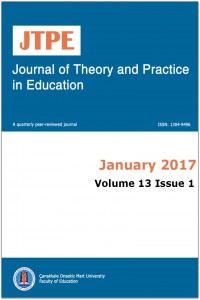ARGÜMANTASYON TABANLI OLASILIK ÖĞRETİMİNİN ORTAOKUL ÖĞRENCİLERİNİN BAŞARILARINA VE KAYGILARINA ETKİLİLİĞİNİN İNCELENMESİ
Abstract
Bu araştırmanın amacı argümantasyon tabanlı olasılık öğretiminin (ATOÖ)
ortaokul 8.sınıf öğrencilerinin matematik başarıları ile matematik kaygılarına
etkisini belirlemek ve öğrencilerin ATOÖ’ye yönelik görüşlerini ortaya
çıkarmaktır. Araştırmanın katılımcıları, 2014-2015 öğretim yılının bahar
döneminde Karadeniz Bölgesi’nin orta ölçekli bir ilinin bir devlet ortaokulunda
öğrenim gören 8.sınıf öğrencileridir (n=51). Araştırmada bir deney (n=26), bir
kontrol (n=25) olmak üzere iki grup yer almıştır. Araştırmada öntest-sontest
kontrol gruplu yarı deneysel desen kullanılmıştır. Deney grubundaki öğrencilere
argümantasyona dayalı öğretim 10 ders saati boyunca uygulanırken kontrol
grubundaki öğrencilerle mevcut öğretim yöntemine dayalı ders işlenmiştir.
Araştırmanın nicel veri toplama araçları, Bindak (2005) tarafından ilköğretim
öğrencilerine yönelik geliştirilen matematik kaygı ölçeği ve Sümersan Seyhanlı
(2007) tarafından ortaokul öğrencilerinin olasılık konusundaki başarılarını
belirlemek için geliştirilen matematik başarı testidir. Araştırmanın nitel veri
toplama aracı ise araştırmacılar tarafından geliştirilen yarı yapılandırılmış
görüşme formudur. Nicel verilerin çözümlenmesinde betimsel ve kestirimsel
analiz yöntemlerinden yararlanılırken nitel veriler içerik analizi tekniğiyle
analiz edilmiştir. Araştırmanın sonuçlarına göre matematik başarısı bakımından
ATOÖ’nün mevcut öğretim yöntemine göre daha başarılı olduğu görülmüştür.
Matematik kaygısı bakımından ise ATOÖ ile mevcut öğretim yöntemi arasında
anlamlı bir farklılaşma tespit edilememiştir. Deney grubundaki öğrencilerin
uygulanan ATOÖ’ye yönelik görüşlerinin olumlu olduğu sonucuna ulaşılmıştır.
Keywords
References
- Akınsola, M.K., & Anımasahun, I.A. (2007). The effect of simulation-games environment on students achievement in and attitudes to mathematics in secondary schools. The Turkish Online Journal of Educational Technology, 6(3), 113-119.
- Akpınar, E., & Ergin, Ö. (2005). Yapılandırmacı kuramda fen öğretmeninin rolü. İlköğretim Online, 4(2), 55-64.
- Anıl, D., Özer Özkan, Y., & Demir, E. (2015). PISA 2012 araştırması ulusal nihai rapor. Ankara: Milli Eğitim Bakanlığı OSDGM.
- Aydede, M.N., & Matyar, F. (2009). Fen bilgisi öğretiminde aktif öğrenme yaklaşımının bilişsel düzeyde öğrenci başarısına etkisi. Türk Fen Eğitimi Dergisi, 6(1), 115-127.
- Aymen Peker, E., Apaydın, Z., & Taş, E. (2012). Isı yalıtımını argümantasyonla anlama: ilköğretim 6.sınıf öğrencileri ile durum çalışması. Dicle Üniversitesi Sosyal Bilimler Enstitüsü Dergisi, 4(8), 79-100.
- Aziz, Z., & Hossain, A. (2010). A comparison of cooperative learning and conventional teaching on students’ achievement in secondary mathematics. Procedia Social and Behavioral Sciences, 9, 53–62.
- Balcı, C. (2015). 8.sınıf öğrencilerine “hücre bölünmesi ve kalıtım” ünitesinin öğretilmesinde bilimsel argümantasyon temelli öğrenme sürecinin etkisi. Yayınlanmamış Yüksek Lisans Tezi, Adnan Menderes Üniversitesi, Aydın, Türkiye.
AN EXAMINATION OF THE EFFECTIVENESS OF ARGUMENTATION-BASED PROBABILITY TEACHING ON MIDDLE SCHOOL STUDENTS’ ACHIEVEMENTS AND ANXIETIES
Abstract
The purpose of this study is to determine the effects of
argumentation-based probability teaching (ABPT) on middle school 8th grade
students’ mathematics achievements with mathematics anxieties and reveal the
views of the students to ABPT. The participants of the study are 8th grade
students (n=51) studying on a middle state school in the spring semester of
2014-2015 academic terms in one of Black Sea Region little scaled city of
Turkey. There are two groups randomly assigned that experiment (n=26) and control
(n=25) groups. A quasi-experimental design with pre test-post test control
group was used in this study. Discussion-based teaching and the activities
involving probability scenarios were
employed over 10 hours to the students in experimental group, despite that the
course based on the current teaching methods was done with the students in
control group. The quantitative data collection tools of the study are the math
anxiety scale related to elementary school students developed by Bindak (2005)
and the mathematics achievement test to determine the successes of middle
school students in probability topic developed by Sümersan Seyhanlı (2007). The
qualitative data collection tools of the study are semi-structural interview
protocol and the probability scenarios developed by the researchers.
Descriptive and predictive analysis methods were used in the analysis the
quantitative data. The qualitative data were analyzed with content analysis
technique. According to the results of the study, ABPT is more successful than
the current teaching method in terms of mathematics achievement. But, ABPT is
not more successful than the current teaching method in terms of mathematics
anxiety. On the other hand, the students have positive views on ABPT at the end
of the interviews with them.
Keywords
References
- Akınsola, M.K., & Anımasahun, I.A. (2007). The effect of simulation-games environment on students achievement in and attitudes to mathematics in secondary schools. The Turkish Online Journal of Educational Technology, 6(3), 113-119.
- Akpınar, E., & Ergin, Ö. (2005). Yapılandırmacı kuramda fen öğretmeninin rolü. İlköğretim Online, 4(2), 55-64.
- Anıl, D., Özer Özkan, Y., & Demir, E. (2015). PISA 2012 araştırması ulusal nihai rapor. Ankara: Milli Eğitim Bakanlığı OSDGM.
- Aydede, M.N., & Matyar, F. (2009). Fen bilgisi öğretiminde aktif öğrenme yaklaşımının bilişsel düzeyde öğrenci başarısına etkisi. Türk Fen Eğitimi Dergisi, 6(1), 115-127.
- Aymen Peker, E., Apaydın, Z., & Taş, E. (2012). Isı yalıtımını argümantasyonla anlama: ilköğretim 6.sınıf öğrencileri ile durum çalışması. Dicle Üniversitesi Sosyal Bilimler Enstitüsü Dergisi, 4(8), 79-100.
- Aziz, Z., & Hossain, A. (2010). A comparison of cooperative learning and conventional teaching on students’ achievement in secondary mathematics. Procedia Social and Behavioral Sciences, 9, 53–62.
- Balcı, C. (2015). 8.sınıf öğrencilerine “hücre bölünmesi ve kalıtım” ünitesinin öğretilmesinde bilimsel argümantasyon temelli öğrenme sürecinin etkisi. Yayınlanmamış Yüksek Lisans Tezi, Adnan Menderes Üniversitesi, Aydın, Türkiye.
Details
| Journal Section | Makaleler |
|---|---|
| Authors | |
| Publication Date | January 31, 2017 |
| Submission Date | February 11, 2017 |
| Published in Issue | Year 2017 Volume: 13 Issue: 1 |

